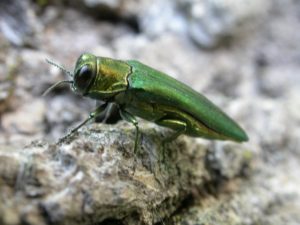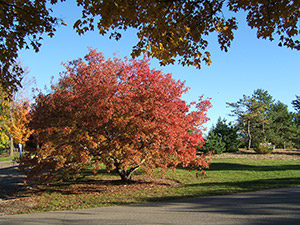Campanula latifolia – one of the species detected as an “emerging” invasive species in the database relied upon by the authors of the study
The authors of a new study note that officials managing invasive species programs rely largely on knowledge of a species’ previous invasion history to predict its level of threat in the geographic area under their responsibility. This approach does not work with the many introduced species that have no history of a previous detected invasion. Hanno Seebens and 49 coauthors – including tree-pest experts Eckehard G. Brockerhoff, Marc Kenis, Andrew M. Liebhold, and Alain Roques — have sought to figure out how great a handicap that lack of data is. See “Global rise in emerging alien species results from increased accessibility of new source.” The study is available for $10 here. Figures, tables, and references are available without charge.
The study used a database of 45,984 first records of establishment of 16,019 species belonging to the following major taxonomic groups: vascular plants, mammals, birds, fishes, insects, crustaceans, mollusks, and other invertebrates.
Last year, many of the same scientists, relying on the same database, found that the rate of new introductions of alien species has risen rapidly since about 1800 – and shows no sign of slowing down. The adoption of national and international biosecurity measures during the 20th century have slowed introductions – but they are not sufficiently effective, especially regarding those plants and animals that are introduced primarily accidentally as stowaways on transport vectors or contaminants of commodities (e.g., algae, insects, crustaceans, mollusks and other invertebrates). The 2017 study found a strong correlation between these “accidental” alien species’ spread and the market value of goods imported into the region of interest. For that study, go here. I blogged about the findings on 1 March 2017 – here.
In the new 2018 article, the scientists found that even after many centuries of invasions the rate of emerging alien species is still high. Across all taxonomic groups, one out of four detections during 2000 – 2005 was of a species that had not been previously recorded anywhere as alien. Detections of “new” or “emerging” aliens is occurring at an even higher rate for some taxonomic groups. But new detections of insects fit the average – every fourth detection during 2000 – 2005 was of a species not previously recorded outside its native range.
The authors conclude that the continuing high proportion of “emerging” alien species is best explained by the interplay of 1) the incorporation into the pool of potential alien species of species native to regions formerly not accessible to traders; 2) increases in introduction rates due to higher import volumes; and 3) probably rising establishment rates as a consequence of land degradation that facilitates establishment in recipient regions. This process compensates for the decrease of new invaders from historically important source regions – from which potentially invasive species have presumably already taken advantage of pathways and been recorded as introduced somewhere.
emerald ash borer Agrilus planipennis – one of the species in the database of “emerging” invasive species
The number of insect species in the database candidate species pool is 20,611 species – an admittedly small fraction of all insects (for example, there are more than 350,000 beetle species worldwide). Twenty-four percent of these insect species have already been established somewhere outside their native ranges. However, the authors note that data gaps – which are larger for some taxonomic groups and geographic regions – mean that the number of actual “first” introductions is probably larger than records indicate, and consequently the estimated size of the candidate species pools may also be higher. Indeed, the paper does not attempt to estimate the actual size of the invasive species “pool” for insects.
The authors analyzed the importance of eight factors – temperature, relative humidity, import values, three land-use categories, number of botanical gardens, and human population size – in explaining the continued high number of “emerging” invaders detected in recent years. While these factors were explanatory for some taxonomic groups, they had a very low predictive value for insects.
For vascular plants, every third record of an introduction in 2000 – 2005 was of an “emerging” alien species. Interestingly, the number of botanical gardens in a country was a significant predictor for emerging alien vascular plants. However, as the authors of the article point out, reliance on this factor ignores the probable importance of other contributors such as the number of species planted in the receiving country; similarities between source and receiving environments; and introductions by acclimatization societies, European explorers or settlers, and plant hunters.
Acer ginnala –one of the species detected as an “emerging” invasive species in the database; photo by J. Weisenhorn, University of Minnesota extension
In any case, lots of previously undetected alien species are detected each year. In this database, 58% of the species had a single record; 86% of all species have no more than two first records in countries on the same continent. The large number of species with only one or two records led the authors to conclude that most species will not spread widely. I question that conclusion because species often require some time to spread to new locations – either local or distant. The authors do admit that they are unable to determine which species have a high potential for spread.
ash trees at the St. Louis arch – before arrival of emerald ash borer
The continued high rate of introduction of new species leads the authors to estimate that between 1% and 16% of all species on Earth – depending on the taxonomic group – qualify as potential invasive alien species. The authors did not attempt to estimate the true candidate pool or percentage of invasive species for insects. For vascular plants, the authors estimated the candidate pool at 47,000 species (out of a total of 368,000 species on Earth), or 13%.
Like its predecessor, this study’s importance arises from its broad perspective – covering the entire globe and a wide range of taxonomic groups. Its major conclusion that invasions will continue on a large scale serves as a warning to all stakeholders. These include officials charged with protecting agriculture and the broader economy, or the natural environment; conservationists; and those engaged in the economic activities that promote invasion.
However, the authors found that the data did not support more specific advice. First, as noted above, they were unable to determine which of the “emerging” invasive species in all taxonomic groups have a high potential to spread.
For those of us focused on invasive species that threaten native plants, data gaps limit the predictive value of the study the most. The database is too scant even to estimate the invasive species “pool” of potential insect pests. Plant pathogens are not included in the analysis.
Posted by Faith Campbell and Phyllis Windle
We welcome comments that supplement or correct factual information, suggest new approaches, or promote thoughtful consideration. We post comments that disagree with us — but not those we judge to be not civil or inflammatory.



